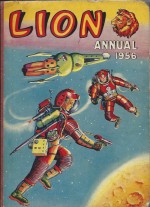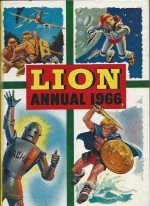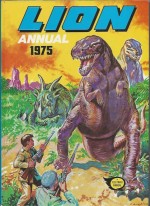Lion Annual 1956


By many and various (Amalgamated Press)
No ISBN:
The 1950s ushered in a revolution in British comics. With wartime restrictions on printing and paper lifted, a steady stream of new titles emerged from many companies and when the Hulton Press’ The Eagle launched in April 1950, the very idea of what weeklies could be altered forever.
The oversized, prestige package with photogravure colour was exorbitantly expensive however, and when London-based publishing powerhouse Amalgamated Press retaliated with their own equivalent, it was an understandably more economical affair.
I’m assuming they only waited so long before the first issue of Lion launched (dated February 23rd 1952), to see if their flashy rival periodical was going to last..
Like Eagle, Lion was a mix of prose stories, features and comic strips and had its own cover-featured space-farer in Captain Condor – Space Ship Pilot.
Initially edited by Reg Eves, the title eventually ran for 1156 weekly issues until 18th May 1974 when it merged with Valiant. Along the way, in the traditional manner of British comics which subsumed weaker-selling titles to keep popular strips going, Lion absorbed Sun in 1959 and Champion in 1966; swallowing Eagle in April 1969 and merged with Thunder in 1971, in its capacity as one of the country’s most popular and enduring adventure comics. It vanished in 1976 when Valiant was amalgamated with Battle Picture Weekly.
Despite its demise in the mid-70s there were 30 Lion Annuals between 1953 and 1982, all targeting the lucrative Christmas market, combining a broad variety of original strips with prose stories; sports, science and general interest features; short humour strips and – increasingly from the 1970s onwards – reformatted reprints from IPC/Fleetway’s vast back catalogue.
That’s certainly not the case with this particular item. Forward-dated 1956 but actually published in late 1955, it’s a delicious dose of traditional comics entertainment, big on variety, sturdily produced in a mix of full-colour sections and a preponderance of starkly potent monochrome, offering a wide variety of treats to beguile boisterous boys – then and now…
I’m sure I don’t need to remind you that these entertainments were produced in good faith in a culture and at a time very different from ours, and occasionally attitudes and expressions are used which we will find a little upsetting. This book is actually one of the better examples of racial, gender and cultural tolerance, but even so…
Opening with an evocative, thematic map of North and South America (mirrored by a second one at the back highlighting Africa, India and New Guinea) and a spectacular painted frontispiece of ‘Sea-Bed Treasure Seekers’ the wonderment begins with ‘Sandy Dean in Guardian of the Secret Chimp’ (scripted by Ted Cowan & illustrated by Barry Nelson), a comic strip saga wherein our ideal schoolboy and his chums get into trouble after someone sends them a baby ape to look after. Next, “Edwin Dale†provides a prose thriller starring troubleshooter Mr. X who stops a con-artist exploiting ‘The Pigmies Who Wanted to Become Giants’ before a pictorial ‘World-Wide Quiz’ tests your general knowledge.
Arthur Deam’s text story about ‘Taming a Trouble-Maker’ features another school stalwart as Bob Belman turns a lout into a sports star with a practical joke and his own shining example before “Jack Maxwell†crafts a rousing comic strip romp starring Len Dalton and Dick Archer – ‘The Jungle Jeep Adventurers’ searching for – and finding – a lost city in the Amazon after which Brian Mead proffers prose lark ‘Spook-Hunter Gerry Gets his Ghost’: a comedic affair of haunted houses and hidden pets…
Sticking with text tales, Brian Ireland’s stirring yarn of Canadian lumberjack skulduggery ‘The Unmasking of the Timber-Camp Traitor’ is followed by general knowledge oddments in ‘Picture Parade of Facts from Near and Far’ and Peter Glassford’s beguiling ‘The Sea-Bed Treasure Seekers’ with a brace of British divers battling sharks and such to recover sunken gold…
Opening the colour comics sections, ‘Captain Condor Fights the Space Pirates’ is by Frank S. Pepper and probably illustrated by original artist Ron Forbes.
When he started in Lion #1, Condor was “The Outlaw of Spaceâ€; a rebel overthrowing a galactic tyrant. By this time however he’s a simple space pilot who encounters an asteroid full of cosmic corsairs and despatches them with doughty deliberation, after which Ray Marr takes us to ancient times in his prose thriller of ‘Marcus the Roman Wrestler’ thwarting a tyrant and securing common lands for the common folk whilst Harry Hollinson D.F.C. depicts some of the soon to be commonplace ‘Wonders of Outer Space’.
As I’m one of those kids still furtively muttering “where’s MY jetpack?â€, I shall move on swiftly and say nothing…
It’s back to school as the Fourth Form teach a japester a lesson in Ronald Knill’s text account of ‘The Downfall of Sammy the Sneak’ before Brett Marlowe, Detective employs the comic strip form to solve ‘The Case of the Chinese Idol’ (as delineated by John Fordice) whilst Australian bush-bandits responsible for the ‘Robbery at Woolshed Creek’ are relentlessly tracked down by Trooper Tom Donnelly and his aborigine tracker pal Jolli – of the Australian Northern Territory Mounted Police Patrol – in Guy Deakin’s prose thriller.
‘Mighty Mabu Saves the Herd’ (illustrated by F.A. Williams) is Mark Aldridge’s text tale of a wise elephant protecting his tribe from drought and human hunters and “Connoly†renders a page of crazy gadgets in ‘They’re Inventors’ Brain-Waves’ before the clearly pseudonymous Dan Colt renders a powerful cowboy-era strip saga as ‘Trapper Ken Foils the Fur Thief’ before we return to school for Tom Stirling’s prose tale of bullies overcome by ‘Skinny’s Smoke Bomb’…
Itinerant trader/skipper Stormy Tate becomes ‘The Man Who Wrecked a Revolution’ in R.G. Thomas’ text tale of the South Seas before another colour comic strip (by E. George Cowan – or Ted to his friends and us Fans) finds us in medieval England where ‘Tony the Circus Acrobat’ and his performing pals overthrow a local lordly tyrant whilst Richard Birnham’s ‘“Rajah†Routs the Railroad Wreckers’ offers a prose saga of pride and patriotism on the steam railroads of imperial India and Derek Knight describes in text the astounding wild west exploits of ‘Sheriff Spike – Racket Buster’…
Pictorial fact-feature ‘When the Romans Went Chariot Racing’ precedes a rollicking WWII comic strip battle blitz by Cliff Hooper as peerless Privates Joe Dale and Shorty Brown investigate the ‘Mystery House in No-Man’s Land’ to find out where all the Germans are disappearing to, after which Kaibu of Samba Island exposes the conniving tricks of a greedy witch doctor in prose tale ‘The Haunted Lagoon’ by Michael Alan whilst Victor Norman describes the astounding and amusing antics of ‘Phido, the Electronic Bloodhound’, before the final comic strip details how two British pilots comprising the ‘Skyway Police for the Desert Sheik’ (by Hugh Tempest) expose a scheme by oil interests to defraud their boss.
The 160 pages of wholesome thrills conclude with a rousing jungle caper in prose form as ‘The T.V. Thrill-Hunters’ go in search of great footage and encounter a lost Inca city and hunters smuggling rare animals… like pterodactyls…
Sadly many of the actual creators are unknown, especially the exceptional artists whose tantalisingly familiar-looking efforts adorn the prose stories, but generally this is still a solid box of delights for any “bloke of a certain age†seeking to recapture his so-happily uncomplicated youth. It also has the added advantage of being far less likely than other (usually unsavoury) endeavours which, although designed to rekindle the dead past, generally lead to divorce…
© 1955 the Amalgamated Press and latterly IPC. All rights reserved.
Lion Annual 1966

By many and various (Fleetway)
No ISBN:
Even though sales of all British comics were drastically declining, the 1960s were a period of intense and impressive innovation with publishers embracing new sensibilities and constantly trying new types of character and tales.
At this time Lion and its stable-mate Valiant dominated the boys’ adventure field although nothing could touch DC Thomson’s Beano and Dandy in the kids’ comedy arena.
From their creative peak comes this book, the 13th Annual (on sale from the end of August 1965), a far slicker, sleeker package, which opens in a blaze of colour with history-feature ‘Fighting Scot’, recounting the Horatian battle of military legend Dr. William Brydon, only survivor of the British Retreat from Kabul in 1842.
The comic action commences with an exploit of a much travelled, much recycled favourite. In October 1960 Karl the Viking debuted in Lion as The Sword of Eingar by Ken Bulmer and Don Lawrence. The one-off became a regular feature and ran until September 1964: a total of 205 instalments, plus four complete tales in the annuals (including one scripted by Michael Moorcock).
The character was subsequently renamed Rolf and Eric as his stories were reprinted in Lion, Smash!, Valiant and elsewhere. The British comics industry generally recycled strips which didn’t date too much approximately every five years, on the mistaken assumption that their readership was transient and temporary, constantly outgrowing picture stories before moving on to more worthy entertainments.
Here ‘Karl the Viking and the Swamp of Fear’ found the bold warrior battling dinosaurs in a fetid bog to ensure the son of a fallen comrade inherited the mantle of chieftainship…
The monochrome section begins with ‘Menace of the Flying Mini’: another historical prose feature this time detailing the amazing life of micro-plane pioneer A. E. Clouston. It is followed by a stunning saga of the Napoleonic era set in 1812. ‘The Little King – Part I: Escape from Hell’ traces the perilous path of young Blaise, heir to the kingdom of Arenburg. When vile regent Rosencranz moves to oust the boy-king, the child barely escapes with his life and, resolved to save his people from tyranny, makes his way across frozen, war-wracked Europe to find embattled Emperor Bonaparte and demand his aid in restoring his rightful rule.
A spectacular work, it’s drawn by one of the great foreign artists Fleetway was using during this period but I just can’t decide who. At this moment I’m torn between Hugo Pratt, Vicente Alcazar, Fernando Fernández or Victor de la Fuentes, but it’s probably some equally brilliant and prestigious master I’m slighting…
Venerable space ace Captain Condor stars in prose puzzler ‘The Mystery Men from Fantasy Planet’, uncovering a vast criminal conspiracy after which Lion‘s iconic and irrepressible mechanical marvel is stolen by American mobsters and becomes ‘Robot Archie – The Metal Monster’ in a black & white comic strip (probably) scripted by Ted Cowan and illustrated by Carlos Pino.
A rollicking text romp set in cavalier days sees a dispossessed lord reclaim his lands with the help of the recently-restored King’s top agent John Quarrel in ‘Two Rapiers for Revenge’ after which ‘The Rommel Raiders’ reveals, in strip form, the history of a daring commando raid on Germany’s greatest general before the war takes to the air in ‘Paddy Payne and the Ghost Squadron’ with the daring Spitfire pilot single-handedly uncovering and eradicating a hidden Nazi airbase…
Photographic optical teasers in ‘Pic Quiz’ segue into the astounding and breathtakingly bombastic conclusion of ‘The Little King’ in ‘Part II: Return to Glory!’ whilst ‘Guess What?‘ asks for more identifications – albeit drawn ones – before a prose thriller sets special agent Vic Gun on the trail of ‘The Plot to Kill’ the president of a friendly nation…
‘Now You Know’ offers a fascinating fusillade of sporting facts and cartoon biography of Wyatt Earp, ‘One of the Fearless’ segues seamlessly into the saga of stalwart Saxon ‘Longsword’ as he battles to protect Normandy from invasion whereafter stunning colour augments the comic strip history of ‘Churchill – the Warrior’ (Pino again?).
‘Rory McDuff in the Mountains of the Sun’ takes the indomitable stuntman on a prose journey into the Arabian deserts aiding of a reformist sheik in fear of his life, after which detective Bruce Kent invites you to Spot the Clue in taxing comic strip teaser ‘Find the Traitor’ whilst ‘Zip Nolan and the Payoff’ finds the ultra-observant Highway Patrolman scuttling a blackmail plot and bank raid in a terse, taut text thriller before everything calms down with an assortment of spot gags in ‘Time for a Laugh’…
Adding context to earlier excitements ‘The Army that Froze to Death’ details how the Russian winter dealt Napoleon’s forces a crushing defeat whilst photo-feature ‘Men on the Moon’ reviews current technology built for the then-forthcoming lunar landing.
‘The Blazing Guns of Wild Bill Hickok’ recounts in prose form a deadly showdown for the legendary gunslinger and the festive fun concludes with another aerial assignment as ‘Paddy Payne and the Flying Secret’ sees the pilot paladin ferret out a spy stealing secrets from his own squadron…
Adapting to a more sophisticated audience, the editors had slowly given Lion a unique identity as the years passed. This collection would be the last to feature a general genre feel. Future years would see the pages filled with an increasingly strange and antiheroic – even monstrous – pantheon which made readers into slavish but delighted fanatics. However, viewed from today’s more informed perspectives this book is a magical collection of graphic treats and story delights that will enchant any kid or adult.
© Fleetway Publications Ltd. 1965. All rights reserved.
Lion Annual 1975

By many and various (Fleetway)
No ISBN;Â SBN 85037-141-4
Being almost universally anthology weeklies, British comics over the decades have generated a simply incomprehensible number of strips and characters in a variety of genres ranging from the astounding to the appalling. Perhaps it’s just personal bias based on being the right age at the right time, but the early 1970s adventure material from Fleetway Publications seems to me the most imaginative and impressive.
Fleetway was a small division of IPC – the world’s largest publishing company – and had, by the early 1970s, swallowed or out-competed all other outfits producing mass-market comics except the exclusively television-themed Polystyle Publications.
As it always had been, the megalith was locked in a death-struggle with Dundee’s DC Thomson for the hearts and minds of their assorted juvenile markets – a battle the publishers of the Beano and Dandy finally won when Fleetway sold off its dwindling comics line to Egmont publishing and Rebellion Studios in 2002.
This is technically the last proper Lion Annual. In May 1974 the long-running title was merged with Valiant as very much the junior partner. Valiant itself was to be absorbed into Battle Picture Weekly two years later. However although the title itself was winding down, the Christmas Annual market worked on different principles and retailers seemed ever-eager to see familiar names when stocking up on one-off big-ticket items.
The memory of many defunct comics survived for years beyond their demise because publishers kept on banging out hardback collections for titles parents and retailers remembered from their own pasts.
Lion Annual 1975 was released in Autumn 1974, the 22nd since the comic began in 1952. There would be eight more before the hallowed name finally vanished from vendor’s shelves…
Boasting the traditional blend of full-colour, duo-tone and monochrome sections, this titanic tome kicks off with the wonderfully preposterous ‘Marty Wayne – He’s Heading for Fame!’ This star-struck kid was such a talented mimic he was occasionally used by MI-6 for emergency missions and here he’s sent by his spymaster boss to infiltrate a circus and ferret out a scurrilous saboteur after which a prose tale of ‘The Spellbinder’ (probably written by Tom Tully and illustrated by regular strip artist Geoff Campion) found young Tom Turville and his ancient alchemist ancestor Sylvester breaking all the rules – and the Fourth Wall – to rescue the mystically kidnapped creative staff of Lion. Apparently the magician’s arch enemy Tobias wanted to have a comic starring just him alone…
In a stunning black-&-white strip illustrated by the Solano Lopez studio, immortal time-castaway ‘Adam Eterno’ then washes up in a dystopian future to battle deadly cultists and surprisingly team up with the ubiquitous, undying Sylvester Turville (potential script candidates include Chris Lowder, Tully, Ted Cowan and Donne Avenell) before Reg Parlett’s priceless puss ‘Mowser’ wins another hilarious battle with obnoxious butler James…
‘Rory McDuff and the Sargasso Sea Monster’ pits the troubleshooting paranormal investigator against modern day pirates and their pet dinosaur in a stunning thrill-ride limned by the inimitable and brilliant Reg Bunn, after which Spot-the-Clue highway patrolman ‘Zip Nolan’ tracks down a brace of bandits and a neat photo-feature details the history and hobby of collecting ‘Postcards’.
The Jungle Robot debuted in the first issue of Lion in 1952, created by E. George “Ted†Cowan & Alan Philpott, before vanishing until 1957. On his return in the 1960s as ‘Robot Archie’ he became one of the most popular and long-lasting heroes of British comics and in this prose outing – with pictures by Ted Kearnon – the amazing automaton and his hapless handlers Ted Ritchie and Ken Dale find themselves fighting a full-fledged alien invasion…
Maintaining the mechanical man mystique in comedic drama strip-form is Frank S. Pepper & Alex Henderson’s ‘Steel Commando’; a sturdy survivor of the March 1971 merger with Thunder who here, with his partner – portly nerdish Lance-Corporal Ernie “Excused Boots†Bates – is ordered to seize a vital railway station before the Nazis can use it to reinforce the line.
As ever “old Ironsides†is ready and able but Ernie’s feet are playing up…
‘Heads with a History’ is a photo-feature on ship’s figureheads after which a popular serpentine super-villain makes his first appearance in a potent prose yarn.
Angus Allan & John Catchpole’s ‘Shadow of The Snake’ had begun in the weekly anthology in 1972; cataloguing the outrageous crimes of mad scientist Professor Krait who could transform himself into a reptilian rogue with all the assorted evolutionary advantages of the world’s ophidian denizens.
Here the bizarre bandit was in Brazil to perpetrate a bold bank heist with his mortal nemesis and former lab assistant Mike Bowen advising the bewildered, overmatched police…
A quartet of pictorial info-pages declare ‘It’s a Fact!’ before another nigh-legendary weird warrior appears in a text tale.
The Spider was a mysterious super-scientist whose original goal was to be the greatest criminal in the world. As conceived by Ted Cowan he began his public career by gathering a small team of crime specialists before attempting a massive gem-theft from a thinly veiled New York’s World Fair. As time progressed, committing crime proved no challenge and the Awesome Arachnid turned his coat and started hunting super-villains.
Here ‘The Spider and the Molecule Man’ finds him and long-suffering, still crooked assistants Pelham and Ordini chasing a nuclear menace with the ability to infinitely replicate himself before the aforementioned ‘Robot Archie’ clanks back to centre stage in a splendid red, black and white strip by Cowan & Kearnon with the mechanical marvel battling thieves wielding a stolen growth-acceleration ray…
Following a laugh break courtesy of ‘Leo’s Joke Page’, fantasy football takes hold as ‘The Team Terry Kept in a Box’ (Frank S. Pepper & Mike White) had to win a crucial replay. What nobody knew was that player manager Terry was the only living member of Anstey Albion: all the rest were historic sporting figures captured on Victorian stereo-opticon plates and reanimated long enough play individual matches. Here that replay is almost lost when Terry is hit by a bus and almost misses the match…
It’s back to monochrome and prose action as ‘The Steel Commando’ (and Ernie) show the Americans how to clear a Pacific island of entrenched Japanese soldiers and Parlett tickles ribs with a visit from anarchic kid-gang ‘The Lion Street Lot’ before ‘The Silver Colt’ reveals a pitiless rivalry between two WWI aviators.
Superbly drawn by Ian Kennedy, the spectacular strip was originally serialised in Lion during 1965, but with a little judicious editing makes for a splendidly entertaining extended complete tale here.
‘Marty Wayne’ gets the text thriller treatment next, imitating the Vice President of a hostile nation, after which ‘Zip Nolan’ is back in strip action tracking an industrial spy before humour takes hold with two more examples of ‘Leo’s Joke Page’ and another rousing duel between ‘Mowser’ and James whilst the castle is burgled. Then Campion displays his astounding talents in a stupendous full-colour ‘Spellbinder’ strip with Tom and Sylvester Turville trapped in fantastic realms: a cunning counterpoint to the Adam Eterno story seen earlier…
‘Paddy Payne and the Fire Raiders’ finds Joe Colquhoun’s astounding Air Ace (limned here, I suspect, by foreign hands) fighting a devilish new incendiary weapon before the Statue of Liberty is explored and explained in ‘The Tallest Lady in the World’. Then ‘The Last of the Harkers’ finds hapless final heir Joe and his ghostly coach attempting to reclaim a dead ancestor’s unpowered flight record to save the family seat…
The fun and thrills wrap up in that order as one more ‘Mowser’ mirthquake shows the fat cat’s infinite capacity for expensive food before ‘The Shadow of the Snake’ falls across the Andes in a stellar strip by Allan & Catchpole with the sinister serpent man raiding a lost valley of dinosaurs in search of genetic traits he can add to his insidious arsenal…
This is a glorious lost treasure-trove for fans of British comics and lovers of all-ages fantasy, filled with danger, drama and delight illustrated by some of the most talented artists in the history of the medium. Track it down, buy it for the kids and then read it too. Most of all pray that somebody somewhere is actively working to preserve and collect these sparkling and resplendent slices of our fabulous graphic tradition in more robust and worthy editions.
© IPC Magazines Ltd. 1974. All rights reserved.
